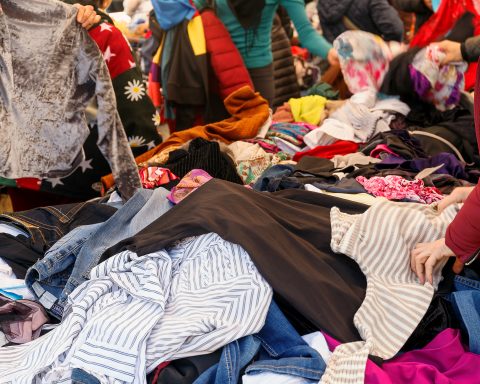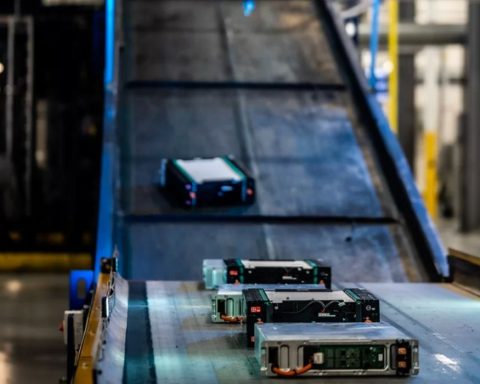Every year, hundreds of thousands of volunteers fan out along beaches and waterways around the world to rid the landscapes of that haunting by-product of consumer culture: disposable plastic. Peeking through the mountain of debris is a ray of hope: new research is drawing a correlation between plastic bag bans in the United States and a drop in plastic bags collected as part of this massive cleanup.
According to Washington-based Ocean Conservancy, volunteer trash collectors found 29% fewer plastic bags on U.S. beaches in 2022 and 2023, compared to levels that were collected prior to the pandemic. At the same time, since 2020, the percentage of the U.S. population covered by plastic bag bans has doubled, from 12% to 25%, the advocacy group reported in its September study.
“The best way to prevent plastic grocery bags from becoming plastic pollution is by making and using fewer of them in the first place,” noted Anja Brandon, Ocean Conservancy’s director of plastics policy, in a statement. “This analysis confirms that bans are an effective way to deal with this problematic plastic.”
This is welcome news for a world clamouring for solutions that can make a difference in the climate crisis. For two and a half years, an Intergovernmental Negotiating Committee at the United Nations has been discussing phasing down the production of plastic, which is made from fossil fuels, and thus greenhouse-gas-intensive, as part of a global plastics treaty that’s supposed to be wrapped up by December 1.
A 2017 study from the University of California at Santa Barbara calculated that the world produced about nine billion tonnes of plastic between 1960 and 2015 – and 80% of it still exists, in landfills and oceans. About 12% of that total production was incinerated (releasing volatile organic compounds); just 9% has been recycled. With industrial nations sending their plastic waste to less developed countries around the world, plastic has crossed into the water we drink and the air we breathe. Scientists have found 1,500 animal species, from birds to whales, that ingest plastic waste, and microplastics have been found in human placentas, kidneys and, to much consternation, testicles.
Worse still, the planet now produces half a million tonnes of virgin plastic a year, 40% of it for packaging. With the growing trend of single-serving food – and with the oil companies’ hopes to ramp up plastic production as oil and gas give way to renewable energy sources – annual production has been forecast to double by 2050.
A key counterforce is the new plastics treaty. But oil-producing nations such as China, Saudi Arabia, Russia and the United States have opposed production cuts, arguing without much evidence that better plastic-cleanup projects and recycling tools can solve the problem.
Suddenly this summer, the Joe Biden administration did an about-face, announcing it would phase out single-use plastics throughout the U.S. government – the world’s biggest procurer of plastics. And in August, while Kamala Harris’s candidacy for president dominated the news, word quietly went out that Washington would accept production cuts as part of a program of “raising ambition.”
The administration, it seems, took seriously a recommendation from an advisory committee on plastic pollution and a circular economy: “Successfully combating plastic pollution requires the United States to take a comprehensive approach that addresses the impacts of plastic throughout the entire lifecycle – from production to end of life.”
RELATED:
The moment of truth is now here for plastic pollution
Canada bans some single-use plastics; are takeout containers enough?
Is the burgeoning ‘plastic credits’ market a new wave of greenwashing?
The report said that Biden had already accepted the notion of a multifront battle. “Tackling plastic pollution and its associated impacts will require unprecedented action at every stage of the plastic lifecycle – from reining in the pollution from petrochemical production that is poisoning communities and driving climate change, to reorienting infrastructure to ensure dramatic increases in recycling and reuse, to investing in innovative materials to replace the pervasive use of plastics in our society.”
Environmental activists praised Biden’s new agenda, with Greenpeace calling it “a watershed moment.” But a major chemical-industry group called it a “betrayal” of U.S. manufacturing interests.
It’s important to understand just how thoroughly the plastics industry has evaded responsibility for the harm done by its fossil-based products. Many studies have documented that as waste plastics started to pile up, the industry pushed recycling as the solution – even though most commercial plastics can’t be recycled, and the hundreds of varieties of plastics are nearly impossible to sort efficiently. A 2020 investigation by National Public Radio found one operator of a San Diego recycling business who said he was puzzled to find more and more unrecyclable plastics showing up in his bins in the early 1990s. He then realized all those plastics bore the triangle/arrow logo that most people today recognize as a ready-to-recycle symbol. It seems the plastics industry lobbied state governments to require the symbol on all plastics – even those that couldn’t be reused. “It’s pure manipulation of the consumer,” he told NPR.







